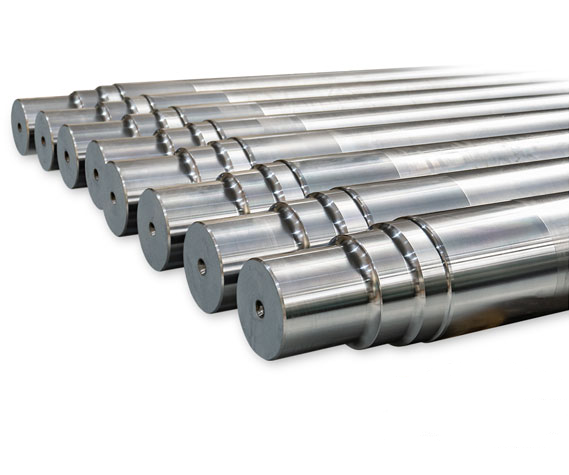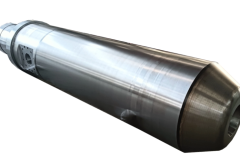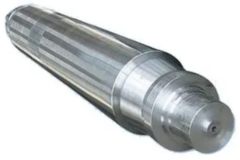Big Shaft
If you are looking for Large Shaft Machining, get in touch today and we will provide you with an accurate quote and our best services.
Please visit Large Shaft Machining for detailed technical information about our Large Shaft Machininig.

Advantage of Big Shafts
- High Load Bearing Capacity: Big shafts are designed to withstand heavy loads and transmit torque efficiently. Their large diameter and robust construction enable them to handle significant loads without deformation or failure, making them ideal for heavy-duty applications such as in industrial machinery, marine propulsion systems, and power transmission systems.
- Stability and Rigidity: The large size and solid construction of big shafts provide excellent stability and rigidity, ensuring smooth operation and minimal deflection even under high loads. This stability is crucial for maintaining precision in critical applications such as in precision machinery, large rotating equipment, and aerospace components.
- Longevity and Durability: Big shafts are typically made from high-strength materials such as steel alloys or specialized alloys designed to withstand harsh operating conditions, corrosion, and wear. This durability ensures long service life and minimal maintenance requirements, reducing downtime and operational costs over the shaft’s lifespan.
- Versatility: Big shafts are used in a wide range of industrial applications, including power generation, mining, oil and gas, aerospace, automotive, and marine industries. Their versatility stems from their ability to accommodate various mounting configurations, coupling arrangements, and drive mechanisms to suit different application requirements.
- Customization: Big shafts can be customized to meet specific design and performance criteria, including dimensional tolerances, surface finish requirements, material specifications, and special features such as keyways, splines, threads, or bearing surfaces. This customization allows for tailored solutions to fit unique application needs and performance objectives.
- Efficiency and Performance: By efficiently transmitting power and torque, big shafts contribute to the overall efficiency and performance of machinery and equipment. Their robust construction minimizes energy losses due to vibration, deflection, or slippage, resulting in smoother operation, higher productivity, and improved reliability.
- Integration with Advanced Technologies: Big shafts can incorporate advanced technologies such as sensor systems, predictive maintenance solutions, and surface coatings to enhance performance, monitoring capabilities, and service life. These advancements enable proactive maintenance strategies, real-time monitoring, and optimization of equipment operation for increased uptime and productivity.
Material Information of Big Shaft
- Steel Alloys:
- Carbon Steel: Carbon steel is widely used for big shafts due to its excellent strength, hardness, and affordability. It offers good wear resistance and can withstand heavy loads. However, it may be susceptible to corrosion in certain environments.
- Alloy Steel: Alloy steel contains additional alloying elements such as chromium, nickel, molybdenum, or vanadium to enhance properties such as strength, toughness, and corrosion resistance. Alloy steel shafts are commonly used in high-stress applications where increased durability and performance are required.
- Stainless Steel:
- Austenitic Stainless Steel: This type of stainless steel offers excellent corrosion resistance and is suitable for applications where exposure to moisture, chemicals, or corrosive environments is a concern. It is often used in marine, chemical, and food processing industries.
- Martensitic Stainless Steel: Martensitic stainless steel provides high strength, hardness, and wear resistance. It is suitable for applications requiring high mechanical properties and resistance to abrasion and fatigue.
- Titanium Alloys:
- Titanium alloys offer a combination of high strength, low density, and excellent corrosion resistance, making them ideal for aerospace, marine, and chemical processing applications. Titanium shafts are lightweight yet strong, making them suitable for applications where weight reduction is critical.
- Nickel Alloys:
- Nickel alloys, such as Inconel and Monel, offer superior resistance to corrosion, oxidation, and high-temperature environments. They are commonly used in aerospace, chemical processing, and oil and gas industries where extreme conditions are encountered.
- Copper Alloys:
- Copper alloys, such as bronze and brass, offer good machinability, corrosion resistance, and thermal conductivity. They are suitable for applications requiring electrical conductivity, such as electrical motors and generators.
- Composite Materials:
- Composite materials, such as carbon fiber reinforced polymers (CFRP) or fiberglass reinforced polymers (FRP), offer high strength-to-weight ratios, corrosion resistance, and fatigue resistance. They are used in specialized applications where weight reduction, vibration damping, or non-metallic properties are required.
- Ceramics:
- Advanced ceramics, such as silicon nitride or alumina, offer exceptional hardness, wear resistance, and thermal stability. They are used in high-speed rotating shafts, bearings, and cutting tools where extreme conditions are encountered.
Sources
- American Foundry Society. “Metal Casting”
- Wikipedia. “Investment Casting“, “Sand Casting“
- efunda. “Sand Casting“
- The Investment Casting Institute. “What is Investment Casting?“
- The Library of Manufacturing. “Investment Casting“
- Forging Industry Association “Forging Industry“
Our Internal Resources for Die Casting, Investment casting, Forging and Sand Casting
- Die Casting
- Aluminum Die Casting
- Zinc Die Casting
- A356 Aluminum Casting with T6 Heat Treatment
- Magnesium Die Casting
- Investment Casting
- Stainless Steel Casting
- Duplex Stainless Steel Casting
- Super Duplex Stainless Steel Casting
- Titanium Casting
- Carbon & Low Alloy Casting
- Forging
- Cold Forging
- Hot Forging
- ECO BRASS C69300 Brass Forging
- Sand Casting (Aluminum Sand Casting, Ductile Iron Sand Casting, Gray Iron Sand Casting)
- Specialty Fittings and Fasteners
- Precision CNC Machining and Secondary Operations



